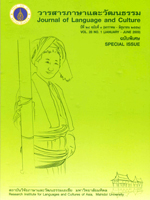Ethnicity and the Dara-ang (Palaung) in Thailand
Main Article Content
Abstract
This study is about an ethnic group called Palaung, who are known as Pale by the Burmese and the Shan people. During 1982-1984, a group of around 200 Palaung people migrated from Doi Lai, Shan State in the southern part of Myanmar to No Lae Village, Fang District, Chiang Mai Province in the northern part of Thailand. The village is located approximately 5-6 kilometers north of the Ang Khang Royal Project on the Thai-Myanmar border. The group that moved to No Lae call themselves “Dara-ang ren” or “Red Dara-ang” and speak the Dara-ang language of the Palaungic branch of the northern Mon-Khmer sub-groups, Austroasiatic language family. This paper provides brief information about Palaung language classification, the migration into Thailand, locations and demography. Based on Barth (1969)’s “ethnic boundary” and Hobsbawm and Ranger (2000)’s “invented tradition”, the Dara-ang at No Lae have established their own ethnic identity both by an adaptation of the old and an invention of the new, namely dissemination of information about HM the King’s permission to stay at No Lae, women’s beautiful dresses and rattan or bamboo waist hoops, the legend of their ancestor “Roi Ngoen” and the dance, the ritual of making offerings to village guardian spirits and naming.
Article Details
How to Cite
Deepadung, S. (2014). Ethnicity and the Dara-ang (Palaung) in Thailand. Journal of Language and Culture, 28(1), 7. retrieved from https://so03.tci-thaijo.org/index.php/JLC/article/view/20193
Section
Research Articles
The articles featured in the Journal of Language and Culture (JLC) constitute academic works representing the viewpoints of the respective author(s). It is crucial to note that these opinions do not necessarily reflect those of the Editorial Board.
All articles published in JLC are released under the Creative Commons Attribution 4.0 International License (CC BY 4.0). This license grants permission for unrestricted use, distribution, and reproduction in any medium, provided proper credit is given to the original author(s) and the source.


